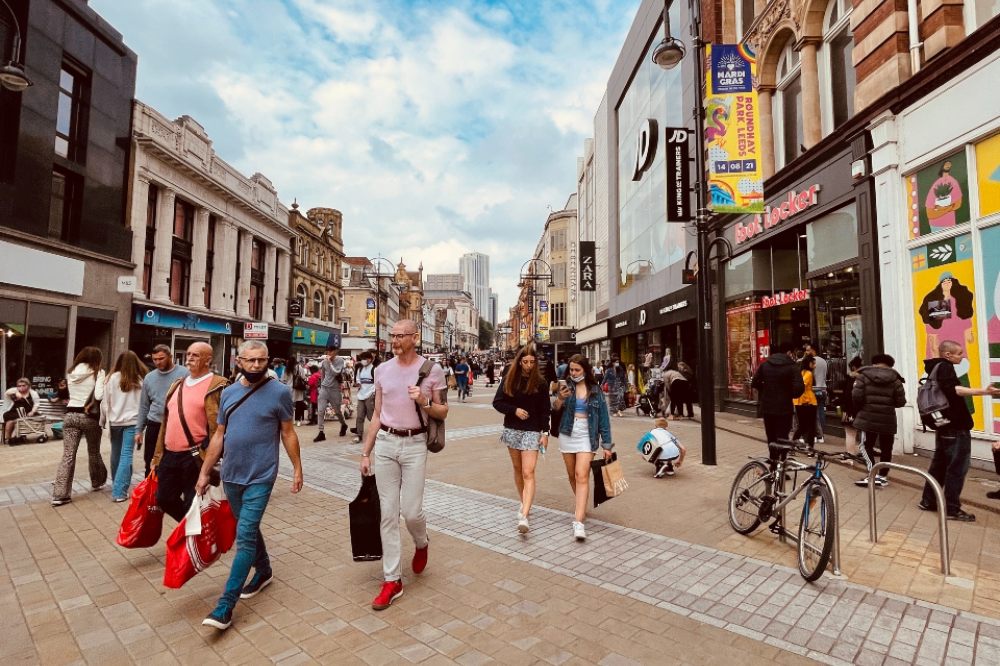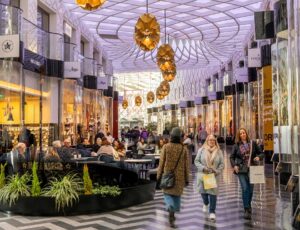
2022 was the first full year of normal retail trading conditions since the start of the pandemic in March 2020. However, examining the recovery in footfall in UK destinations over the whole of 2022 incorporates two very different time periods.
The first was the first four months of the year from January to April, when in 2021 the UK was still in lockdown and all but non-essential retailers remained closed. The second period was from May through to December, when in 2021 all stores were opening and trading. In the light of this, retail expert Springboard has split the year into two parts. The first from January to April and the second from May to December.
The extent of the recovery in footfall over the 12 months from January to December 2022 was in line with Springboard’s forecast of a gap from the 2019 footfall level of between -10% and -15%. Over the year as a whole, footfall across UK retail destinations was -14.2% below the 2019 level, with a steady improvement from -20.8% below 2019 in January 2022, to -10.9% in December 2022.
However, the uplift from 2021 varied significantly between the four months to April, when the comparison with the lockdown period in 2021 meant that footfall rose by +104.4% over the year and the eight months from May when footfall was +10.8% above the 2021 level.
The extent of the recovery in footfall varied across the UK
The areas performing best in terms of the balance between the recovery back to the pre-pandemic footfall level and the annual increase from 2021 were Greater London, the East, the East Midlands and Wales.
Between May and December, footfall in the Greater London region (which includes both Central London and Outer London) rose by +19.1% and was -8.2% lower than in 2019. In the East, footfall rose by +10.5% from 2021 and was -8.5% lower than in 2019. In the East Midlands, footfall rose by +9.7% from 2021 and was -14.3% lower than in 2021. Finally, in Wales, footfall was +10.9% higher than in 2021 and -13.3% lower than in 2019.
Alongside the uplift in footfall from 2021, five key trends identified by Springboard throughout the period of the pandemic still held true in 2022.
1. The ongoing gap from pre-pandemic footfall
With a gap from the 2019 footfall level of -14.2% over the 12 months from January to December, the gap from pre-pandemic footfall is clearly a long term trend. This has been exacerbated by the other four trends.
2. Continued consumer localism
The increase in localism that emerged during Covid endured during 2022, particularly in respect of the difference in the extent of recovery in footfall in Central London vs Outer London. In Central London over the May to December period, footfall was -17.8% below the 2019 level versus -9.1% in Outer London.
The comparison of footfall recovery in market towns and city centres outside of the capital diminished during 2022, with large cities attracting back footfall. In 2021, footfall in market towns was -30.9% below the 2019 level versus -37.8% in city centres around the UK. By 2022, however, the position had shifted. Footfall in market towns was -17.9% below 2019 versus -14.6% in city centres over the 12 months (-15.8% versus -11.5% between May and December).
Part of the difference between the extent of localism in London versus elsewhere during 2022 is due to the proximity of residential areas to the main retail and business core in cities outside of the capital, which means it is easier to make trips to larger centres. Plus, the fact that outside of London visitors tend to be less dependent on public transport and so are less impacted by rail strikes.
3. The rise and rise of hybrid working
Hybrid working is driving much of the ongoing trend for localism. Springboard’s quarterly Retail Consumer Survey identified that in 2022 an average of 55% of consumers worked at home for at least some days each week, with very little change in the extent of home working across the year.
The lowest proportion of home working amongst consumers of 50% was recorded in July 2022. However, by December 2022, this had risen to 53%. The most significant change in home working in 2022 was the number of days when consumers worked at home. In January, 30% of consumers stated that they worked at home every day but by November 2022 this has fallen to 18% of consumers. In contrast, 28% of consumers stated in January that they worked at home for some days each week (not all) and by November this had risen to 34% of consumers.
The impact of hybrid working on footfall has largely been evident in a lower rate of recovery back to the 2019 level in high streets during weekdays. It is high streets – with its concentration of offices – that feel the impact of the drop in office based workers to a greater degree than shopping centres or retail parks, which are predominantly retail-based locations.
Over the 12 months in 2022, high street footfall during weekdays (Monday to Friday) remained -18.2% below the 2019 level. During the weekends, however, it recovered to -11.8% below 2019. In shopping centres the difference between the recovery in weekday footfall and weekend footfall was far less significant. Consumers are able to access many shopping centres whilst working at home, with a gap from 2019 of -20.8% during weekdays versus -18% during weekends. And in retail parks footfall recovered more from 2019 during weekdays than at weekends (-1.1% between Monday and Friday versus -3.4% on Saturday and Sunday).
The positive news for retail destinations is that over half of consumers surveyed who work for at least some of the week at home have not changed their shopping habits at all (52%). At the same time, there are some underlying shifts in consumer behaviour being driven by hybrid working that may ultimately provide a pressure on retailers to alter how they manage their operations in terms of opening hours or staffing rosters and levels; 21% of consumers stated they visit destinations less frequently, 16% visit more in the evening or at the weekend and 11% visit on different days.
4. Drop in online spending
Whilst footfall in retail destinations strengthened over the 12 months in 2022, the importance of online spending diminished from a peak reached during the pandemic. During Lockdown 3 in February 2021, 65% clothes and footwear spending was carried out online. This more than tripled from January 2020 when it accounted for 20.5%. Subsequent to the peak it has fallen away significantly. In December 2022, 24.9% of spending for clothes and footwear was carried out online.
5. The resilience of retail parks
The resilience of retail parks in retaining footfall has been a feature of the physical retail landscape since the start of Covid. Not only do most retail parks host a food store so shoppers keep returning to these destinations on a regular basis, but they are easy to reach by car, which was key during the pandemic when travelling on public transport was a concern to shoppers and now can be problematic during rail strikes.
In addition, the fact that these locations comprise large stores means shoppers felt more comfortable in retail parks when infection rates were high. This meant that in 2022 footfall in UK retail parks was just -3.7% below the 2019 level (-3.1% below 2019 from May to December). And in December, footfall in retail parks was just -0.8% below 2019. In contrast, footfall in high streets and shopping centres over the May to December period averaged -14.2% and -16.8% below 2019 respectively.
Commenting is Diane Wehrle, Insights Director at Springboard
“The question on everyone’s lips now that we are firmly in the midst of the pandemic recovery period, is what are the trends that are going to be prevalent during 2023? Unbeknown at the time of the pandemic was the cost of living crisis and resulting increase in inflation that would await consumers and impact on spending during the latter part of 2022, which will continue through to 2023 and most likely beyond.
“Inevitably, this will act as a constraint to the number of trips made to retail destinations, as household budgets come under increasing strain. Alongside this, however, is the positive trend for the desire of shoppers to return to shopping in store, evident from the reduction in the significance of online spending and the steady recovery in footfall towards the 2019 level.
“At the same time, hybrid working is now an established feature of the UK economy and will act as a further downward pressure on the recovery of footfall to the 2019 level. Whilst hybrid working and the ability of stores and destinations to adapt will be a key factor in determining their success, the fact is that in the absence of Covid footfall across UK destinations would have declined each year anyway.
“Over the decade that Springboard has been publishing its data, footfall declined by an average of -1.3% per year each year from 2009. And so, even with the absence of Covid, footfall across UK retail destinations would now be circa -4% lower than in 2009. Taking this into account, with all things being equal, footfall will not return to pre-pandemic footfall levels, and in 2023 Springboard anticipates that the gap from 2019 will settle at between -5% and -10%.”













